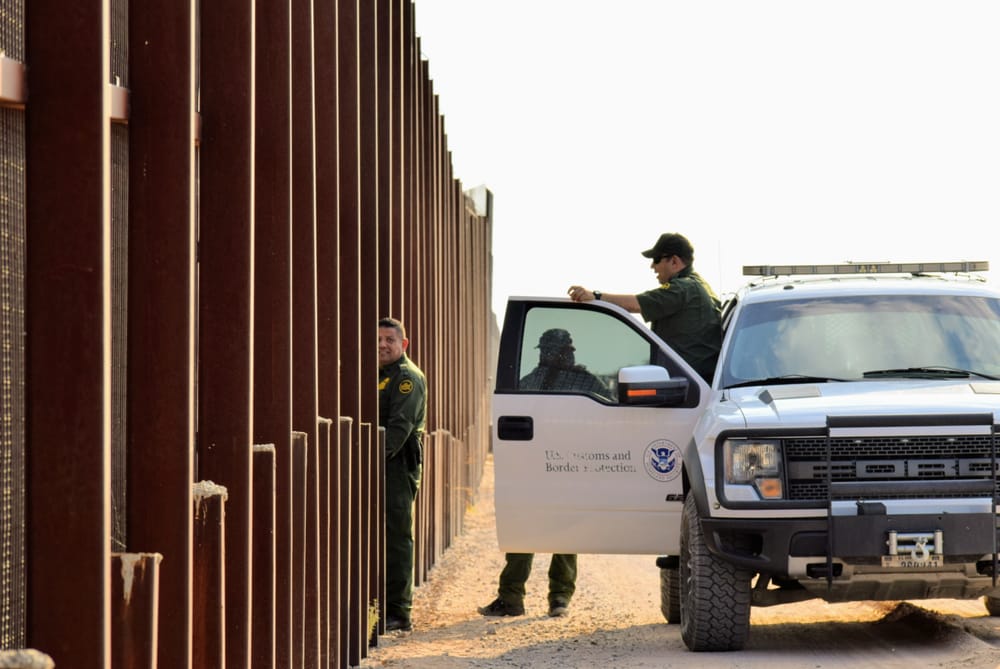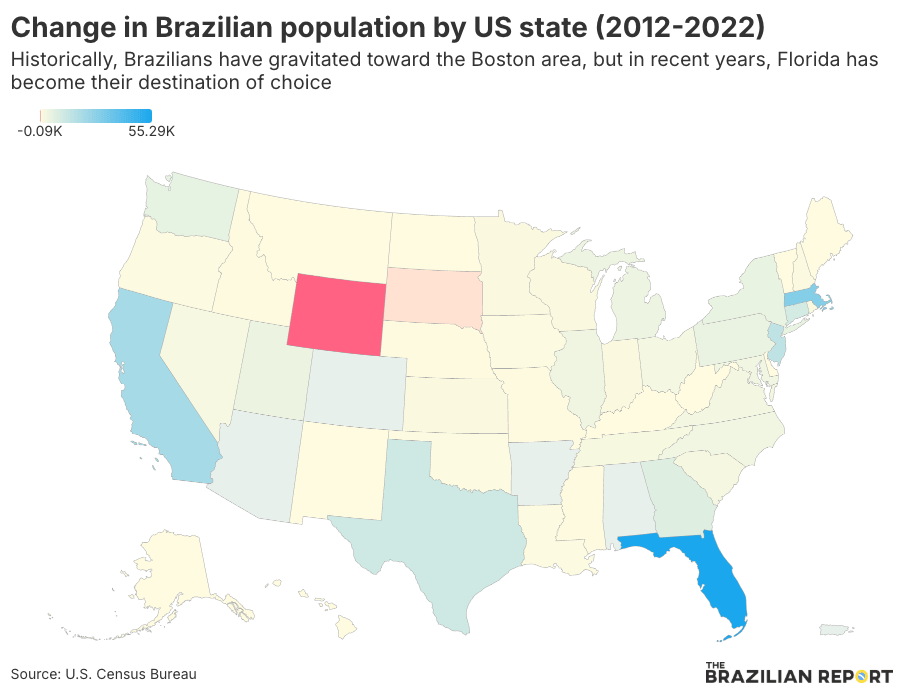Hello! Welcome to another edition of the Brazil Society newsletter! This week, we’re talking about the profile and figures of the Brazilians who have migrated to the US.
If you have any questions about this newsletter, or topics you’d like to see covered in future issues, you can reach me at [email protected]

Brazilian immigrants in the US brace as immigration crackdown heats up

US Customs and Border Protection agents in Santa Teresa, New Mexico. Photo: Winston O'Neal/Shutterstock
The Donald Trump administration’s crackdown on undocumented immigrants has sent waves of anxiety through foreign communities across the United States, including among Brazilians living in American cities.
News reports describe an atmosphere of “panic and fear,” even among families with legal status, as they worry about the harsh tactics employed by immigration authorities. While deportations had already accelerated under the Joe Biden administration (2021-2025), concerns have been amplified by the Trump government’s rhetoric, newly issued executive orders, and the grim conditions under which the first 88 Brazilians were repatriated.
For many, concerns are close to home, either for themselves or for someone they know. Trump has committed to carrying out "the largest domestic deportation operation in American history.” The US Immigration and Customs Enforcement (ICE) reports that 38,000 Brazilians, or 2% of the total number of Brazilians living in the US, already have deportation orders out against them.
The US is home to the world’s largest Brazilian diaspora, with roughly 1.9 million living there as of 2022, according to Brazilian government data. The largest Brazilian communities can be found in New York, Boston, Miami and Orlando, as noted in our Oct. 10 Brazil Daily newsletter.
About 12% of them (roughly 230,000 people) are undocumented, the Pew Research Center said in a recent study.
From January to September 2024, nearly 23,000 Brazilians were detained at the US border, ranking Brazil 17th among countries with the most nationals apprehended. Mexico topped the list with 466,000 detentions, followed by Venezuela (165,000) and Haiti (158,000).

Still, Brazilian migration to the US is by no means defined by illegality. More than 40,000 Brazilians obtained green cards or became US citizens in 2023 alone. Naturalizations, which stood at 12,570 last year, have more than tripled since 2004, according to the immigration consultancy AG Immigration.
American companies have also been hiring increasing numbers of Brazilian workers. In 2023, the top employers of Brazilians included Dakota Provisions, United Maintenance Company, West Liberty Food, United Temps, Turkey Valley Farms, Microsoft, Pecan Deluxe Candy Co., New Angus, Google and Nash Organization Inc.
Moreover, as we showed in our Jul. 25 Brazil Daily newsletter, an increasing number of Brazilian businesses are turning to the US for their expansion plans. Brazil has become the second nationality to obtain the most L-type visas, behind only India.
According to Brazil’s Foreign Affairs Ministry, roughly 45% of Brazilian entrepreneurs opening businesses abroad are doing so in the US.
A shifting migration pattern
The Brazilian population in the US has surged by 265% over the past two decades, according to the American Community Survey (ACS), having made up 1.3% of the country’s 45.3 million immigrants in 2021.
While past migration waves were largely driven by economic hardship, the last two decades also saw a rise in student migration. Many of these Brazilians benefited from exchange programs designed to promote international education, reshaping the country’s migration profile.

Brazil now ranks fifth among the countries with the highest number of students enrolled in American schools and universities, with 41,700 Brazilians studying or participating in exchange programs, according to the consultancy Viva América.
Migration patterns also vary by state. In Massachusetts, for instance, Brazilian immigration intensified in the 1980s, during a period of high unemployment and inflation in Brazil. Many migrants engaged in “shuttle migration,” working in the US during the summer and returning home for summer in the southern hemisphere, according to Alvaro de Castro e Lima, founder of Instituto Diáspora Brasil.
However, stricter immigration enforcement in later years made this back-and-forth movement more difficult, prompting many to settle permanently. By the 1990s, more women and entire families began migrating, shifting the composition of Brazilian communities in the US.

One city, in particular, has played an important role in Brazilian immigration to the Boston area: Governador Valadares, in Minas Gerais, singled out by a study from Boston University as the Brazilian city that contributed the most to international migration flows to the state of Massachusetts in the 1990s.
The flow of Brazilians to the US is so central to Governador Valadares that the city gained the nickname “Vala-Dollars.” In a relatively short time, Valadarenses played an important part in the local Massachusetts economy. Valadares even became Framingham’s sister city in 2004.
The deep-rooted migration trend from Governador Valadares to the US dates back to World War II, when the region became a key supplier of mica (then a strategic material for military insulation and radio production) mined by American companies.
Even as the war ended and the industry collapsed, US-Valadares ties endured, with American engineers bringing some Brazilian workers back. These early pioneers, sharing stories of opportunity abroad, sparked a migration wave that has since defined the city’s identity.
Who are the Brazilians living in the US?

Little Brazil is a small neighborhood in Manhattan, New York City, centered on the single block of West 46th Street between Fifth and Sixth Avenues. Photo: Alexandre F. Fagundes/Shutterstock
Drawing a precise demographic portrait of Brazilians in the US is challenging, particularly given the number of undocumented residents. However, local studies provide some insight.
In Greater Boston, home to the second-largest Brazilian communities, the average age of Brazilian immigrants was 35 years in 2022, according to a survey by Diáspora Brasil, based on ACS data. More than 84% were of working age (18 to 64), with children and adolescents making up 22.4% of the community and seniors accounting for just 4%.
Brazilians have also made their mark as entrepreneurs, running more than 24,000 small and medium-sized businesses in industries such as real estate development, construction, law, accounting, hospitality, domestic services and beauty care.
“There are signs of a growing network of Brazilian entrepreneurs teaching and mentoring newcomers through online platforms and business groups,” the survey noted.
Monica Ribeiro, former head of the Brazilian Census Support Committee, told Acontece magazine in 2022 that Brazilians in the US have experienced greater economic and social mobility than many other immigrant groups.
Indeed, only 10.3% of Brazilians in the US lack a high school diploma, compared with 25.6% of the overall foreign-born population.
Religion and politics
A new study by Taylor C. Boas of Boston University sheds light on a striking political trend among Brazilian expatriates in the US: they tend to be more conservative than the average Brazilian.
While the electorate narrowly rejected far-right former President Jair Bolsonaro in the 2022 presidential runoff (against Luiz Inácio Lula da Silva), Brazilians abroad — especially in the US — overwhelmingly backed him. In Boston, Bolsonaro secured nearly 76% of the vote, surpassing his support even in Brazil’s more conservative regions.

Boas argues that religion, particularly evangelical Christianity, plays a central role in shaping these political preferences. Drawing on exit polls, focus groups and church service observations, the study finds that evangelical Brazilians in the Boston area were the most likely to support Bolsonaro. However, the study suggests that political endorsements from clergy had little direct influence.
Instead, religious congregations foster a conservative worldview that reinforces support for right-wing populism in subtle, indirect ways. Social norms within churches, rather than explicit political messaging, appear to guide congregants toward candidates who align with their values on issues such as family, nationalism and opposition to progressive social policies.
The implications of this trend extend beyond expatriate voting. Brazilian religious communities abroad maintain strong ties to churches in Brazil, potentially influencing political attitudes back home. Boas notes that this transnational network of faith-based political identity mirrors similar trends in India and Turkey, where diaspora communities have played a role in strengthening right-wing populist movements.
Other stories we’re following
🏳️⚧️ Data published by the National Association of Travestis and Transsexuals (Antra) shows that Brazil continues to be the most fatal country for trans people in the world, with 122 victims in 2024 — 66% of them under the age of 35. Between 2017 and 2024, 78% of trans people murdered were black.
🎓 CAPES, the federal agency responsible for postgraduation programs in Brazil, plans to make it mandatory for postgraduate students to do complete internships in the production sector. It aims to encourage these qualified professionals to enter the business world, since 83% of PhDs work in higher education.
🚫 Federal authorities rescued four Argentines from slave-like working conditions in the grape harvest in São Marcos, in the southern state of Rio Grande do Sul. The case is still under investigation. In 2023, a scandal of that nature involved three of the country's largest wineries.









